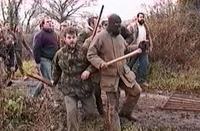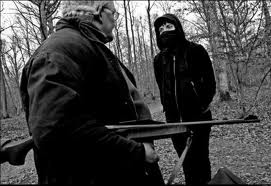Still working to recover. Please don't edit quite yet.
Hunt saboteur
Hunt sabotage is the direct action (WP) that animal rights (WP) or animal welfare (WP) activists (WP) undertake to interfere with hunting (WP) activity, and hunt saboteurs of course the actors in that activity.
Anti-hunting (WP) campaigners are divided into those who believe in direct intervention and those who watch the hunt to monitor for Wikipedia:cruelty and report violations of animal welfare laws. Interventionists may lay false trails or use sound and visual distractions to prevent the hunters from being successful, and enter[1] hunting estates and farms to disarm animal traps.[2]
Non-interventionists use video, photography and witness statements to support prosecution of hunters who commit offenses or to raise awareness of issues showing hunting as cruelty to animals (WP), ineffective or, in the case of those not averse to using propaganda, a bad light.
In the United Kingdom (WP) the interventionists are often (but not always) members of the Hunt Saboteurs Association (WP), while the non-interventionists are often members of the Wikipedia:League Against Cruel Sports or, more recently, Wikipedia:Protect Our Wild Animals or the Wikipedia:International Fund for Animal Welfare.
In Spain (WP), every year organizations such as Equanimal or the platform Matar por matar, non[3] are involved in the sabotage of the Copa Nacional de Caza del Zorro (Spanish: "National Fox Hunt Cup") following the hunters making noise with megaphones to scare foxes and preventing them from being killed.[4][5]
Contents
[hide]Hunt sabotage in the UK before and after the 2004 Hunting Act[edit]
Both hounds and beagles rely entirely on their sense of smell to follow animals that are out of sight, and their baying is usually a response to being able to see the animal.[6] Citronella oil, was marketed in the UK as a means of preventing dogs mating under the brand name Anti-Mate, and in the USA as a means of calming barking dogs;[7] both of these purposes rely on Citronella's ability to create olfactory fatigue by overloading olfactory receptors.
Humans and dogs and pretty much anything that smells have smell receptors in their noses that normally pick up new smells, but each receptor can only become attached to so many 'odor molecules' at a time, and each overloaded olfactory receptor neuron that signal smell from that receptor will therefore no longer activate nerve impulses in response to new smells. In the presence of more 'odor molecules' than can be cleared from the receptors, no new smells will be detectable at all, in much the same way as the noses of people who work in sewers become overloaded until they can no longer smell the stink.
Spraying citronella on the ground, in the path of hounds on the scent, can result in the dogs being able to smell anything other than Citronella, and put them off the scent of the fox for several hours, giving the fox a chance to escape.[8] Hunt saboteur leaders would typically navigate the maze of public roads in the hunting area, and the more daring ones, private access roads as well, while attempting to discern the hunt's course and speed and therefore its likely destination.
Finding a likely location, the leaders and helpers, equipped with spray bottles of citronella, would jump out of the van and furiously spray the ground until the area was covered, the police arrived, or the inevitable local farmer wannabe 'servants of the Laird' Hunt Supporters showed up with their baseball bats.
Dogs respond to the sound of other dogs in pursuit, and will head towards that sound, which can be replicated adequately by sound recordings and played back at will, anywhere that directs the dogs away from where the fox is.[8]

Field Masters control their dogs to a certain extent with hunting horns; hunt saboteurs can also gain a degree of control over their dogs with hunting horns.[8] This is ostensibly a considerably easier tactic than citronella spraying, but skillful emulation of the Field Master's own style of sounding the horn requires practice and may pay benefits.
Get there first[edit]
Prep'ing an area with citronella ensures that certain areas that may be difficult to access during the hunt are covered. Pretty much negated by rain.
The most effective way of preparing an area, though, is to ensure that foxes are no longer in the area in the first place, for the hunt to find. A generous amount of field work in finding the foxes' den (earth) or dens in the area, plus fireworks used the night before the hunt, are a (mostly) safe way of alerting foxes to dangers they have no other way of discerning, and persuading them to find more suitable digs.
Hunts will fill in the entrances to fox earths to prevent foxes taking refuge there during the hunt; unblocking them will at least delay the hunt should the fox go to earth during the hunt.[8] In the hunt days, this was all that could be done, but now that hunting is illegal, should a blocked earth be found, then full photographic documentation of the scene before clearing it would be a great help.
After the Act[edit]
Monitoring the activities of trail hunts can 'keep them honest' to a certain extent, and provide evidence of violations, typically hounds diverting from a dragged scent trail and attacking wildlife.[10]

Again, preparation yields benefits, and knowing which areas are most sensitive to hunt activity can help put pressure on hunts that are either negligent or malevolent in choosing sensitive hunt sites.
Moving foxes on from a location, as in the pre-Act days, is viable if it can be done with certainty that it provides more benefits than harm; ie certainty that they will not return or move to another part of the hunt area, also bearing in mind that fireworks do disturb them.
Monitoring[edit]
Sabs.org checklist[10]
- I want to come out monitoring/sabbing, what do i need to bring?
- video camera - if you have one
- maps
- clothes that keep the weather out
- shoes or boots suitable for running across muddy fields
- something to eat
- something to drink
- transport
- money towards fuel
- a garden spray if you have one
See also[edit]
- Wikipedia:Hunt sabotage Edit histories are where the action is; the other guys helpfully point out what (they think) is most disadvantageous to them by deleting it
- Wikipedia:Category:Environmental organizations by country
- Wikipedia:Category:Animal rights movement
- Anti-hunting (WP)
- Hunt Saboteurs Association (WP)
- Libera! Barcelona animal rights organization (WP)
- Nonviolent direct action
References[edit]
- Hunting and Hunt Saboteurs: A Censure Study, Elizabeth Stokes, UEL School of law: Staff: Research publication series. In-depth and unexpectedly neutral and perhaps even supportive analysis of Hunt Saboteuring /sabotage and the law
- History of the American Hunt Saboteurs Association
External links[edit]
Citations[edit]
[11]- Jump up ↑ HSA Tactics Book - Legal
- Jump up ↑ Traps & Snares: Secret Sabotage
- Jump up ↑ Equanimal se suma a la espantada del zorro el dÃa de la copa nacional 08/02/2007 La Voz de Galicia Template:es
- Jump up ↑ Incidentes entre cazadores de zorros y ecologistas acaban con un detenido 28/01/2008 Wikipedia:La Voz de Galicia Template:es
- Jump up ↑ «Es una matanza, no una competición deportiva», afirman los ecologistas 24/01/2009 Wikipedia:La Voz de Galicia Template:es
- Jump up ↑ How To Hunt the Clean Boot, Daniel Engber, 17 Feb, 2005
- Jump up ↑ Segelken, Roger (1996). Study: 'Nuisance-barking' dogs respond best to citronella spray collars. Cornell Chronicle. URL accessed on 2009-04-22.
- ↑ Jump up to: 8.0 8.1 8.2 8.3 About what we do and who we are Sabs.org
- Jump up ↑ Hunting and Hunt Saboteurs: A Censure Study, Elizabeth Stokes, UEL School of law: Staff: Research publication series
- ↑ Jump up to: 10.0 10.1 About what we do and who we are: Monitoring Sabs.org
- Jump up ↑ May contain content from Wikipedia
- Anarchopedia
- Anarchopedia essays
- Pages with broken file links
- Animal rights movement
- Animal rights activism
- Animal rights activists
- Animal liberation
- Direct action
- Nonviolent direct action
- Hunt sabotage
- Cruelty-free alternatives
- Animal rights
- Hunting
- Dog sports
- Fox hunting
- Equestrian sports
- Activism techniques
- DIY articles